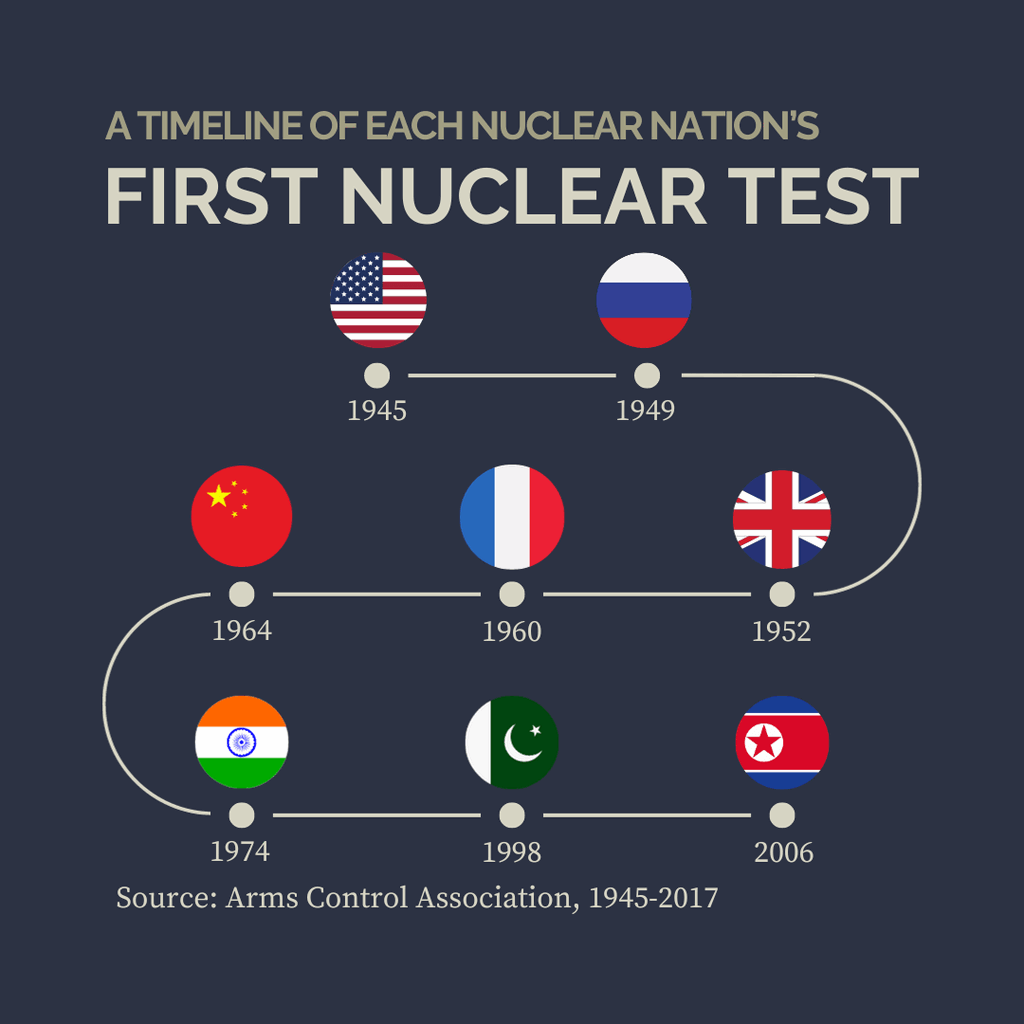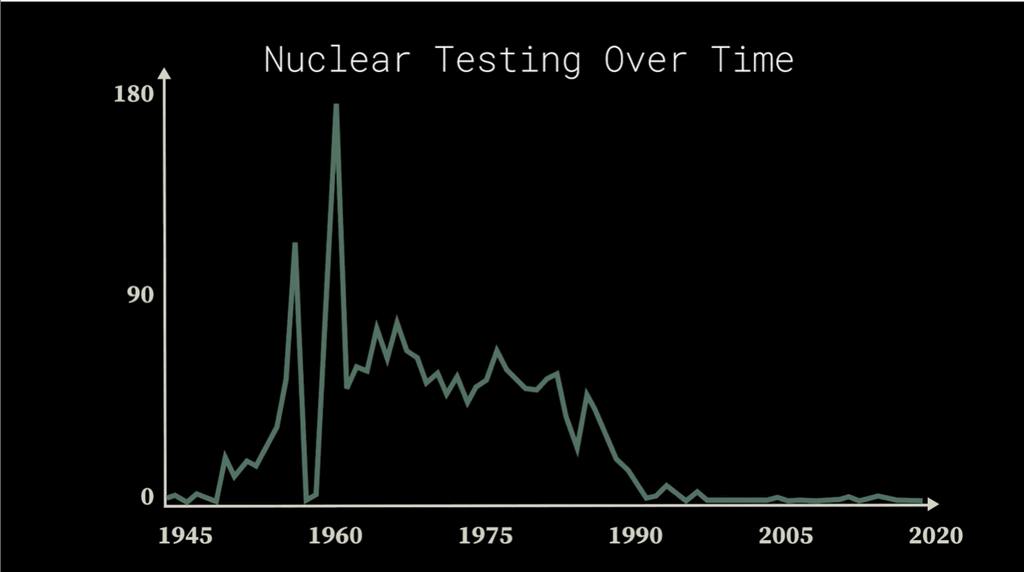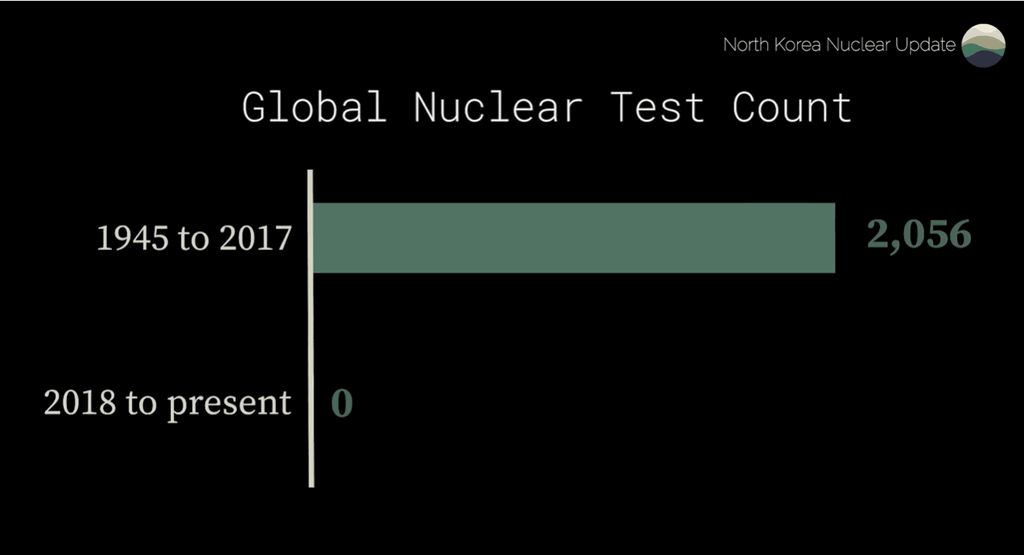
Nuclear testing is an essential step for any country attempting to develop nuclear weapons. A nuclear test is a controlled nuclear explosion conducted to assess a nuclear weapon’s efficiency, the amount of energy it releases upon detonation (yield), and its explosive potential. There are four types of nuclear tests – atmospheric, underground, upper-atmosphere (more than 30km above ground) testing, and underwater.
The United States conducted the world’s first nuclear test at the Trinity Test site in Los Alamos, New Mexico on July 16th,in 1945. Made famous by the Manhattan Project and recent film, Oppenheimer, the Trinity Test confirmed that nuclear fission could be used to make a new kind of weapon. After the test, the Truman administration ordered the use of the bombs on Hiroshima and Nagasaki in August of the same year.
The Soviet Union acquired nuclear weapons in 1949 with their first test. Soon after, Britain, France, and China all tested their nuclear weapons. With the exception of South Africa and Israel, every country that developed nuclear weapons publicly announced their nuclear test.
Nuclear Testing: Who paid the price?
Historically, there has been a relationship between nuclear weapons testing and the exploitation of poorer or weaker countries and communities. For example, former colonial powers exploited the power imbalance over marginalized and indigenous communities by testing nuclear weapons on their lands. Although nuclear testing was conducted in relatively deserted areas, the aftermath of testing can be profound, causing long-term health effects, such as radiation poisoning, cancer, and genetic damage. France’s nuclear testing in Algeria, US testing in the Pacific Islands, and Soviet testing in Kazakhstan, to name just three examples, imposed terrible human costs on the local populations.
Negotiating Limits on Nuclear Testing
Treaties limiting and banning nuclear testing are among the most significant achievements in arms control. In the 1950s and 1960s, global protests against nuclear weapons testing encouraged policymakers to take action in the face of a growing arms race. In 1963, U.S. President John F. Kennedy and Soviet leader Nikita Khrushchev negotiated the Limited Test Ban Treaty, which banned all nuclear tests in the atmosphere, outer space, and underwater. This treaty was negotiated following the 1962 Cuban Missile Crisis.

Efforts to eliminate nuclear testing culminated in the 1996 Comprehensive Nuclear-Test-Ban Treaty (CTBT), which prohibits its members from conducting tests with fissionable material that generate “criticality.” (“Sub-critical” tests are permitted.) The CTBT also established a growing network of monitoring stations and verification efforts to detect the occurrence of a nuclear test.
The US, China, Egypt, Israel and the United States have signed the treaty but not ratified it. Nevertheless, signatories are expected to comply with the provisions of a treaty while awaiting ratification. Russia had ratified the CTBT, then recently reversed itself, seeking to return to a status of signature without ratification. It justified the move by saying it was doing what the US was doing. And finally, India, Pakistan, and North Korea have not signed or ratified the treaty, and so are not bound by its limits.

Nuclear Testing Today: Ominous Signs
In recent years, as the competition between nuclear-armed countries has intensified and arms control agreements have been tossed aside, there are fears that the world may be headed back to a dark period of testing and nuclear arms racing. Satellite imagery of Russian, Chinese, and US testing laboratories suggests that those governments are increasing their efforts. No country that has signed the CTBT has said they would start testing again, but Russia, China, and the US have all suggested that they must make preparations in case other nations withdraw. These “preparations” are viewed by each country’s enemies as suspicious, and they undermine confidence in one of the most important pillars of international nuclear weapons restraint.
But what can I do?
What to help create a safer world? There are a number of civil society organizations that work to reduce the threats posed by nuclear weapons. Visit the Arms Control Association’s nuclear testing fact sheets or check out the Center for Arms Control and Non-Proliferation.
Bibliographic Notes
Sources used in the video content
- Justin McCurry. “North Korean Nuclear Test Confirmed in Major Escalation by Kim Jong-un.” The Guardian, September 3, 2017. https://www.theguardian.com/world/2017/sep/03/north-korean-nuclear-test-confirmed-in-major-escalation-by-kim-jong-un
- Eric Cheung, Brad Lendon, and Ivan Watson. “Exclusive: Satellite Images Show Increased Activity at Nuclear Test Sites in Russia, China, and US.” CNN, September 23, 2023. https://www.cnn.com/2023/09/22/asia/nuclear-testing-china-russia-us-exclusive-intl-hnk-ml/index.html
- David E. Sanger. “Putin’s Move on Nuclear Treaty May Signal End to Formal Arms Control.” The New York Times, February 21, 2023. https://www.nytimes.com/2023/02/21/world/europe/putin-new-start-treaty.html
- Filipp Lebedev and Mark Trevelyan. “Russian Lawmakers Vote to Scrap Ratification of Nuclear Test Ban Treaty.” Reuters, October 18, 2023. https://www.reuters.com/world/europe/russian-duma-passes-law-revoke-ratification-nuclear-test-ban-treaty-2023-10-18/#:~:text=The%20lower%20house%2C%20the%20State,by%20415%20votes%20to%20zero
- A. Schumann. “Fact Sheet: Nuclear Testing 101.” Center for Arms Control and Non-Proliferation. January 18, 2023. https://armscontrolcenter.org/fact-sheet-nuclear-testing-101/
- Campaign for Nuclear Disarmament. “The History of CND.” July 6, 2021. https://cnduk.org/who/the-history-of-cnd/
- The Nuclear Testing Tally. The Nuclear Testing Tally | Arms Control Association. (n.d.). https://www.armscontrol.org/factsheets/nucleartesttally
- U.S. Department of State. U.S. Department of State. (n.d.). https://history.state.gov/milestones/1961-1968/limited-ban#:~:text=In%20the%20early%201960s%2C%20U.S.,Test%20Ban%20Treaty%20of%201963
- U.S. Department of the Interior. Anti-nuclear Activists and Protest Actions (U.S. National Park Service). National Parks Service. (n.d.). https://www.nps.gov/articles/antinuclearactivism.htm
- Union of Concerned Scientists. “What Is Nuclear Testing?” (n.d.). https://www.ucsusa.org/resources/what-nuclear-testing
For More Information
Here are some great books that tell the history of nuclear testing from different perspectives. Silencing the Bomb: One Scientist’s Quest to Halt Nuclear Testing (Columbia University Press, 2017) is L. R. Sykes’s insider account by an American scientist who was an eye-witness to nuclear negotiations. For an international take, look at Togzhan Kassenova’s Atomic Steppe: How Kazakhstan Gave Up the Bomb (Stanford University Press, 2022) which examines the legacy of Soviet nuclear testing in Kazakhstan. More broadly, Toshihiro Higuchi reinterprets nuclear testing and its opposition as part of a larger environmental movement in Political Fallout: Nuclear Weapons Testing and the Making of a Global Environmental Crisis (Stanford University Press, 2020)
For more on nuclear testing, check out the Arms Control Association’s nuclear testing fact sheets. To learn more about nuclear testing alongside other issues surrounding nuclear weapons, check out the Center for Arms Control and Non-Proliferation.

